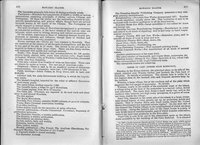422-423
| Previous Page | Next Page |

|
The barometer generally falls below 30 during southerly winds.
Population.—Honolulu has a population of 23,000 or 24,000, of various nationalities, consisting principally of whites, natives, Chinese, and Portuguese. Of these the whites are the controlling element in commercial, manufacturing, and general affairs, though there are several business houses in the hands of the Chinese. The Portuguese are chiefly engaged in manual labor.
The most intelligent class of Hawaiians are employed in government or commercial positions; of the lower classes of the natives some are laborers; others exist by fishing, farming, and various occupations.
Of the whites, Americans or those of American descent largely predominate in numbers and influence, though those of German and British extraction are very prominent.
Horses, carriages, etc.—Hacks are very common in Honolulu. They are stationed at the corners of all the main thoroughfares, and the fare to any part of the city is 25 cents. The horses in use are said to be superior to those of many large cities. There are four livery stables, well equipped with saddle and carriage animals.
Hotels.—The Royal Hawaiian has accommodations for 150 guests, electric lights, electric bells, water from artesian wells; Eagle hotel; Arlington; Waikiki Villa, at Waikiki, 3 miles from Honolulu, connected by tram cars from Honolulu.
Tram cars.—About 12 or 14 miles of tram-car lines exist. These cars are drawn by mules or horses. The cars are of American make.
Telephones.—There is said to be an excellent system of telephonic communication; two companies; rates low; 1,300 telephones in use.
Public buildings.—Iolani Palace, in King street, said to have cost $500,000.
Aliiolani hall, the main Government building, in which the Legislature meets.
The Queen's hospital, intended for the relief of afflicted Hawaiians of both sexes, gratis.
The opera house, seating capacity 1,000.
The Lunalilo home, a home for aged Hawaiians.
The insane asylum, from 50 to 75 inmates.
The Oahu jail. Prisoners are required to do road work and other labor in and around Honolulu.
The fish market.
The Royal Mausoleum.
Honolulu Free Library, contains 10,000 volumes, on general subjects.
Young Men's Christian Association building.
Post office building.
Police station house for the reception of petty offenders.
Current publications.—Pacific Commercial Advertiser, frequency of publication unknown.
The Hawaiian Gazette, a weekly publication.
The Kuokoa, a weekly publication.
The Bulletin, an evening daily.
Ka Leo, native, daily and weekly.
Holomua, native, weekly.
Elele, native, weekly.
Monthly publications.—The Friend, The Anglican Churchman, The Planter's Monthly, The Paradise of the Pacific.
A Tourist's Guide is issued annually.
The Hawaiian Annual
|
The Hawaiian Gazette Publishing Company possesses a very complete printing establishment.
Manufacturing.—Honolulu Iron Works, incorporated 1877. Number of hands employed, usually about 200. This institution is said to be equipped with excellent appliances in all its departments.
Honolulu Steam Rice Mills—Large quantities of rice milled for home and foreign use.
Hawaiian Carriage Manufacturing Company.—Manufacture to order and attend to all kinds of repairing; deal in and keep on hand wagon makers' supplies.
Hopper's Planing Mill and Iron Works.—Extensive plant, said to execute all kinds of work in wood and iron.
Enterprise Planing Mill.—Sash, doors, etc
Lucas Bros.—Sash, doors, etc.
Hawaiian Gazette.—Bookbinding, etc.
Press Publishing Company.—Well equipped printing house.
Tahiti Lemonade Works.—For manufacture of all kinds of aerated waters.
Another establishment of the same kind.
The usual number of blacksmith and wagon shops, cooperages, etc.
Banking houses.—Bishop & Co.; Claus Spreckles & Co., whose California correspondent is the Anglo-California bank.
The mercantile houses are numerous.
CITIES OF OAHU (OTHER THAN HONOLULU).
Kanehoe, in the Kulau district, the principal place on its side of the island, situated near Waialai harbor, just beneath the Pali, back of Honolulu. No details of settlement. The climate here is cooler by a few degrees than on the leeward side, and frequent showers keep up the verdure.
Waialua, a large village, lies at the northern end of the plain which separates the two ranges of mountains. No details.
Waianae, nearly in the middle of the southwest coast of the island, a village lying at the base of the mountains in a narrow valley, fertile and cultivated. The shore here forms a small sandy bay, and on the southern side, between two high rocky precipices, in a grove of cocoanut trees, stands the village.
Pearl City, situated on the south side of the island, is a large, irregularly-shaped lagoon or inlet, greatly cut up by projecting points and islands. This is Puuloa River and Pearl Lochs, where the United States Government has acquired certain rights.* On the west side of the channel lies Puuloa village, in the neighborhood of which are large salt works. Along the inshore side of the Pearl Lochs is a strip of very fertile land of variable breadth, part of which is under cultivation; behind the land rises gradually to the Ewa plain. Pearl City is said to be one of the pleasantest spots on the island, made accessible by the building of the Oahu Railroad. It is situated
|
|
*In 1887 a treaty between Hawaii and the United States was made which agreed that, on condition of the remission of duties on certain articles of Hawaiian produce, the United States was ceded the exclusive right to establish and fortify a naval station in the Hawaiian Islands. Pearl Harbor was designated as the station.
In 1889 an enlargement of the treaty provisions, so as to confer special advantages upon both parties, was proposed by the United States. It was suggested that the cession of a naval station be perpetual as well as exclusive. Another provision was proposed, viz, to allow the United States to land troops in Hawaii whenever necessary to preserve order. These provisions have not so far been taken advantage of by the United States.
| Previous Page | Next Page |